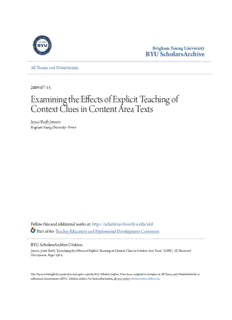Table Of ContentBBrriigghhaamm YYoouunngg UUnniivveerrssiittyy
BBYYUU SScchhoollaarrssAArrcchhiivvee
Theses and Dissertations
2009-07-15
EExxaammiinniinngg tthhee EEffffeeccttss ooff EExxpplliicciitt TTeeaacchhiinngg ooff CCoonntteexxtt CClluueess iinn
CCoonntteenntt AArreeaa TTeexxttss
Jessie Ruth Jensen
Brigham Young University - Provo
Follow this and additional works at: https://scholarsarchive.byu.edu/etd
Part of the Teacher Education and Professional Development Commons
BBYYUU SScchhoollaarrssAArrcchhiivvee CCiittaattiioonn
Jensen, Jessie Ruth, "Examining the Effects of Explicit Teaching of Context Clues in Content Area Texts"
(2009). Theses and Dissertations. 1816.
https://scholarsarchive.byu.edu/etd/1816
This Thesis is brought to you for free and open access by BYU ScholarsArchive. It has been accepted for inclusion
in Theses and Dissertations by an authorized administrator of BYU ScholarsArchive. For more information, please
contact [email protected], [email protected].
EXAMINING THE EFFECTS OF EXPLICIT TEACHING OF CONTEXT
CLUES IN CONTENT AREA TEXTS
by
Jessie Ruth Jensen
A thesis submitted to the faculty of
Brigham Young University
in partial fulfillment of the requirements for the degree of
Master of Education
Department of Teacher Education
Brigham Young University
August 2009
BRIGHAM YOUNG UNIVERSITY
GRADUATE COMMITTEE APPROVAL
of a thesis submitted by
Jessie Ruth Jensen
This thesis has been read by each member of the following graduate committee
and by majority vote has been found to be satisfactory.
_______________________________ ______________________________
Date Kendra M. Hall-Kenyon, Chair
_______________________________ ______________________________
Date Roni Jo Draper
_______________________________ ______________________________
Date Leigh K. Smith
BRIGHAM YOUNG UNIVERSITY
As chair of the candidate’s graduate committee, I have read the thesis of Jessie
Ruth Jensen in its final form and have found that (1) its format, citations, and
bibliographical style are consistent and acceptable and fulfill university and
department style requirements; (2) its illustrative materials including figures,
tables, and charts are in place; and (3) the final manuscript is satisfactory to the
graduate committee and is ready for submission to the university library.
________________________________ _________________________________
Date Kendra M. Hall-Kenyon
Chair, Graduate Committee
Accepted for the Department
_________________________________
Roni-Jo Draper
Graduate Coordinator
Accepted for the College
__________________________________
Barbara Culatta
Associate Dean, David O. McKay School
ABSTRACT
EXAMINING THE EFFECTS OF EXPLICIT TEACHING OF CONTEXT
CLUES IN CONTENT AREA TEXTS
Jessie Ruth Jensen
Department of Teacher Education
Master of Education
The purpose of this study was to examine the effects of explicitly teaching
students how to recognize and use context clues in content-area texts through a six-
week instructional program. Quantitative analyses were performed to reveal any
difference between a control and treatment group. Results indicated that students in
the treatment group abilities to determine the meaning of unknown vocabulary words
were increased significantly more than students in the control group. Students who
received the six weeks of instruction more effectively used context clues to determine
the meaning of unknown words than students who did not receive the instruction.
Recommendations for further research are discussed.
ACKNOWLEDGEMENTS
A huge thanks goes to my committee chair, Kendra Hall-Kenyon, for all
of the time and effort she has put forth to help me successfully complete my
research. I also want to thank my other committee members, Roni Jo Draper and
Leigh Smith, for their feedback, suggestions and support.
A thank you also needs to go out to the third grade teachers and students
who participated in this project and were willing to put forth a lot of time and
effort in helping me make this research possible.
Finally, I want to express appreciation to my wonderful friends and family
who were very patient with me and provided me with endless care and support
throughout the duration of this project.
iv
TABLE OF CONTENTS
Acknowledgements ............................................................................................................ iv Acknowledgements . . . . . . . . . . . . . . . . . . . . . . . . . . . . . . . . . . . . . . . . . . . . . . . . . . . . . .iv
List of Tables ................................................................................................................... viii
Chapter
1. Introduction ..................................................................................................1
Definition and Levels of Vocabulary Knowledge ...........................2
Vocabulary and Content-area Texts.................................................3
Two Types of Vocabulary Instruction .............................................4
Statement of the Problem .................................................................7
Statement of the Purpose .................................................................7
Research Question ...........................................................................8
Definition of Terms..........................................................................8
2. Literature Review .......................................................................................10
Role of Vocabulary in Academic Success .....................................10
Vocabulary Demands In Content-area Texts .................................11
Low-frequency Vocabulary Words and Concepts .............12
Multiple Meaning Words ...................................................12
Words that Carry Critical Meaning ....................................13
Vocabulary Instruction...................................................................14
Intentional Vocabulary Instruction ....................................15
Incidental Vocabulary Instruction......................................17
Purpose of the Study ......................................................................21
v
3. Methods and Procedures ............................................................................22
Participants .....................................................................................22
Design ............................................................................................22
Procedure .......................................................................................24
Treatment ...........................................................................24
Introduction .............................................................26
Modeling .................................................................26
Practice ....................................................................26
Control ...............................................................................27
Fidelity of Treatment .....................................................................28
Data Source ....................................................................................28
Pre-test ...............................................................................28
Post-test ..............................................................................29
Data Analysis .................................................................................30
Limitations .....................................................................................31
4. Results ........................................................................................................33
Pre-test ...........................................................................................33
Post-test ..........................................................................................33
5. Discussion ..................................................................................................36
Implications....................................................................................38
Future Research .............................................................................40
References ..........................................................................................................................42
vi
Appendix
A. Pre-test and Post-test .........................................................................................47
B. Sample Lessons from Instructional Program ....................................................71
vii
LIST OF TABLES
Table
1. Participant Demographics ………………………………………. 23
2. Pre-Test Mean and Standard Error ……………………………… 33
3. Analysis of Covariance Table for Instructional Measures ……… 34
4. Analysis of Covariance Table for Transfer Measures ………….. 35
viii
Description:Brigham Young University - Provo. Follow this and .. The importance of vocabulary knowledge, or the number of words a student knows and uses .. Antonym clue. An antonym clue is when an antonym is found in the context of an.

